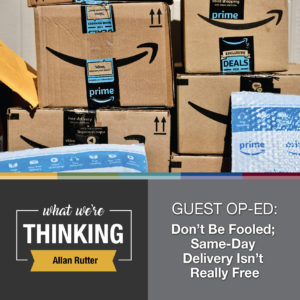50 years ago, when normal people could change their own oil, a mechanic in a television advertisement counseled that replacing the oil filter as part of a regular oil change was a sound investment, “You can pay me now, or you can pay me later.”
This iconic slogan is appropriate for more than car maintenance; it also applies when we look at shopping and delivery trends today.
A new analysis by the World Economic Forum reports that demand for near-instant e-commerce deliveries will increase traffic in major cities over the next decade, boosting tailpipe emissions by 30 percent and expanding traffic delays by 21 percent. This results from an estimated 36 percent growth in delivery vehicles by 2030 to meet urban consumer expectations.
This is a classic good news / bad news picture. Frenetic growth in deliveries means a strong economy, great for employment and consumer confidence. The downside comes as vehicles with all our stuff compound the burdensome travel delays detailed in the 2019 Urban Mobility Report from my colleagues at the Texas A&M Transportation Institute. This unsustainable trend is fueled by how we think about free delivery.
Let’s consider the influence of changing customer expectations. According to a survey by the industry research firm Invesp, 80 percent of shoppers want same-day shipping and 61 percent want their packages within hours of placing an order. The top two reasons for customers choosing same-day delivery: first, they needed the order immediately (50 percent) and second, it was free (29 percent).
So, 29 percent of online shoppers want their stuff right away not because they need it immediately, but simply because they’re not paying extra for it. Let’s consider the applicability of the word “free” in this instance.
The World Economic Forum’s research reveals the costs involved; worsening urban gridlock steals our time and increased emissions threaten our health. The new report also suggests that there’s cause for cautious optimism in the range of possible solutions.
A switch to light and medium-duty electric delivery vehicles, for example, could reduce CO2 emissions. Hyundai and Kia are certainly serious about it, investing more than $100 million in a startup British manufacturer of electric delivery vans. Overall net urban emissions could decrease through a reduction in both mobile sources (fewer diesel-powered vehicles) and emissions from electric generation plants that drift into our neighborhoods (these plants are shifting from coal to cleaner, cheaper natural gas).
Delivery companies could also use dynamic routing software to reduce the mileage and time needed by delivery drivers (and, eventually, robots). And there’s the prospect of using drones, of course.
Give the World Economic Forum credit for suggesting remedies along with their gloomy predictions of gridlock and dirty air. But let’s consider what’s also driving this increase in delivery vehicles.
For much of this old guy’s lifetime, the fastest way to acquire a product –a TV set, a pair of boots, or an economy-size bundle of paper towels – involved visiting a store; getting something delivered meant waiting for weeks. Scrappy retailers and impatient consumers have been steadily chipping away at the differences separating online and brick-and-mortar retail.
Online sales recently jumped to another record-setting share of the 2019 holiday shopping season, generating rippling waves of rapid deliveries (not to mention the stuff we sent back to retailers under no-charge return policies). That may have helped many of us get our gifts but how often did we consider that our rush hours were being rattled by vehicles coming and going from e-commerce distribution centers to bring us our own stuff?
Next-day and same-day delivery aren’t really free, are they? Every box arriving at our front door is tethered to incremental costs to our infrastructure and environment. These are costs we’ll have to pay eventually; the real questions are when, how, and how much. Perhaps as online retailers struggle with higher costs of order fulfillment and logistics, they might consider small premiums for same day deliveries or add incentives for two- to three-day shipping.
With this broader understanding, the next time the finger of this transportation wonk hovers over the same day delivery button for my online purchase, I might stop and consider a hard-earned life lesson, that just because I can do something doesn’t mean that I should do it. How much do I really need that quick delivery? There are times when the fate of our household absolutely requires instant delivery of specialty-sized, heavy-duty litter box liners. Restocking the shelves with paper towels? That can probably wait.
Allan Rutter heads the Freight and Investment Analysis Division at the Texas A&M Transportation Institute, and he is a former Administrator of the Federal Railroad Administration.
This article was originally published in ENO Center For Transportation, February 14, 2020.
